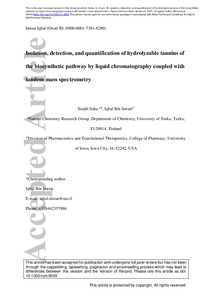Isolation, detection, and quantification of hydrolyzable tannins of the biosynthetic pathway by liquid chromatography coupled with tandem mass spectrometry
Saha Sanjib; Imran Iqbal Bin
https://urn.fi/URN:NBN:fi-fe2021042824752
Tiivistelmä
RATIONALE
Hydrolyzable tannins (HTs) are widely distributed complex secondary metabolites with potential bioactivities and health‐promoting benefits. A highly sensitive compound‐specific UHPLC/MS/MS method is required for their successful detection and quantification in order to advance the study of HTs.
METHODS
In this study, 36 HTs belonging to the HT biosynthetic pathway covering 13 major branches were extracted by cold extraction and fractioned by Sephadex LH‐20 size exclusion chromatography. Followed fractionation, the HTs were purified by semipreparative HPLC so that they could be used for the development of a UHPLC/QqQ‐MS/MS multiple reaction monitoring (MRM) method for their characterization. The cone voltage and collision energy for each HT were extensively optimized during the development of the MRM method.
RESULTS
The developed method was very useful for the detection and quantification of marker tannins with a low limit of detection (LOD) and limit of quantification (LOQ), depending on the size and complexity of the structures of HTs. Each isolated compound was successfully identified and characterized by UHPLC/ESI‐Orbitrap‐MS/MS analysis. In addition, a new methodology for cold extraction and fractionation by Sephadex LH‐20 chromatography has been developed for the targeted extraction of HTs.
CONCLUSIONS
This study has provided a compound‐specific MRM method for the detection and quantification of representative HTs from the diverse phytochemical samples, with higher sensitivity than the existing group‐specific MRM method.
Kokoelmat
- Rinnakkaistallenteet [27094]
